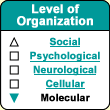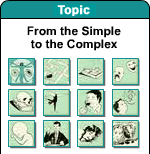|
|
| Funding for this site is provided by readers like you. | |
|
|
|
|
|||||
|
|
|||||||
|
|
|
|
|
|
|
|
At the origin of every thought or action, there are the nerve impulses that travel through the body’s neurons. These impulses are nothing more than the movement of electrically charged inorganic molecules through the neural membrane. But this movement of electrical charges would never allow us to be self-aware if their coordination were not determined by the properties of the channels in the neural membrane. These channels are actually large proteins embedded in this membrane, and their properties are determined by the human genome, itself the result of evolution. The fundamental property of this membrane is that it is semi-permeable. In other words, it allows some charged molecules, known as ions, to pass through more easily than others. Among these ions that play an important role in the nervous system, potassium (K+), which is positively charged, is the one that passes most easily through a neural membrane in its resting state. Sodium (Na+), which also has a positive charge, and chloride (Cl-), which has a negative one, have more difficulty passing through the membrane. Large, negatively charged molecules inside the neuron cannot get out but do also influence the membrane’s electrical potential. To complete the picture, we should note that the calcium ion (Ca++) also plays an important role, but in the process of synaptic transmission. The resting potential is the equilibrium that results from the distribution of these ions on either side of the membrane. In this base state, which is modified by the passage of a nerve impulse, the inside of the neuron is negatively charged relative to the outside. This resting potential measures approximately -70 millivolts.
Click on step numbers 1, 2, and 3 in the diagram below to see how these various kinds of ions are distributed and how they move when a nerve impulse passes down the neuron.
During this “refractory” period, the membrane cannot generate a new impulse, which forces the cycle of opening ion channels to shift down to the neighbouring region of the membrane. In this way, the nerve impulse is propagated down the length of the axon. If the efflux of K+ ions re-establishes the electrical equilibrium
of resting potential, the same is not true of the Na+
and K+ concentration gradient, which must be actively restored
by the neuron. |
|
||||||||||||||||||||||||||||||||||||||||||||||
|
The process that enables a nerve impulse to pass from one neuron to another is called synaptic transmission. This transmission is effected by chemical molecules, called neurotransmitters, which bind to receptors. It is through variations in the amount of neurotransmitters released, the receptors available, or the affinity between the two that the synapses undergo changes and enable us to learn. Synaptic transmission is thus an omnipresent mechanism that is the source of the brain’s great plasticity. Dozens of times per second, at the ends of each of our billions of neurons, the following sequence of events takes place (click the numbers to see each step).
Of course, each of these four major steps
in synaptic transmission actually comprises other
steps. |
| |
|
|
|
|
|
|
|
|




